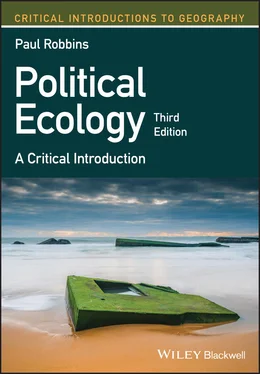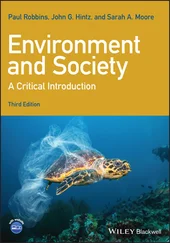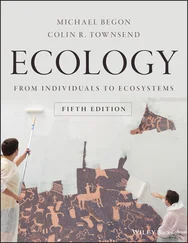1 ...7 8 9 11 12 13 ...19 Otherwise environmentally innocuous production systems undergo transition to overexploitation of natural resources on which they depend as a response to state development intervention and/or increasing integration in regional and global markets. This may lead to increasing poverty and, cyclically, increasing overexploitation. Similarly, sustainable community management is hypothesized to become unsustainable as a result of efforts by state authorities or outside firms to enclose traditional collective property or impose new/foreign institutions. Related assertions posit that modernist development efforts to improve production systems of local people have led contradictorily to decreased sustainability of local practice and a linked decrease in the equity of resource distribution.
The conservation and control thesis
Control of resources and landscapes has been wrested from producers or producer groups (associated by class, gender, or ethnicity) through the implementation of efforts to preserve “sustainability,” “community,” or “nature.” In the process, local systems of livelihood, production, and socio‐political organization have been disabled by officials and global interests seeking to preserve the “environment.” Related work in this area has further demonstrated that where local production practices have historically been productive and relatively benign, they have been characterized as unsustainable by state authorities or other players in the struggle to control resources.
The environmental conflict and exclusion thesis
Increasing scarcities produced through resource enclosure or appropriation by state authorities, private firms, or social elites accelerate conflict among groups (gender, class, or ethnicity). Similarly, environmental problems become “socialized” when such groups secure control of collective resources at the expense of others by leveraging management interventions by development authorities, state agents, or private firms. So too, existing and long‐term conflicts within and between communities are “ecologized” by changes in conservation or resource development policy.
The environmental subjects and identity thesis
Institutionalized and power‐laden environmental management regimes have led to the emergence of new kinds of people, with their own emerging self‐definitions, understandings of the world, and ecological ideologies and behaviors. More firmly: people's beliefs and attitudes do not lead to new environmental actions, behaviors, or rules systems; instead, new environmental actions, behaviors, or rules systems lead to new kinds of people. Correlatively, new environmental regimes and conditions have created opportunities or imperatives for local groups to secure and represent themselves politically. Such movements often represent a new form of political action, since their ecological strands can connect disparate groups, across class, ethnicity, and gender.
Political objects and actors thesis
Material characteristics of non‐human nature and its components (dung, climate, refrigerators, bacteria, lawn grass, road salt, goats, and tropical soils) impinge upon the world of human struggles and are entwined within them, and so are inevitably political. Yet as these characteristics and agents assume new roles and take on new importance, they are also transformed by these interactions. People, institutions, communities, and nations assemble and participate in the networks that emerge, leveraging power and influence, just as non‐human organisms and communities do. In recent history, hegemonic institutions and individuals (environmental ministries, multinational corporations, corrupt foresters) have gained disproportionate influence by controlling and directing new connections and transformations, leading to unintended consequences and often pernicious results. In the process, resistance emerges from traditional, alternative, or progressive human/non‐human alliances marginalized by such efforts (especially along lines of class, ethnicity, and gender).
The target of explanation
Of course, each of these theses actually seeks to explain something somewhat different. While degradation and marginalization offers an explanation of why environmental systems change (e.g., because of capital accumulation), environmental subjectivity research seeks to explain why social identities change (e.g., because of transformed environmental institutions). This diversity of targets for explanation has been the source of some confusion in the field (Vayda 2009; Vayda and Walters 1999) and reflects its historic development.
Research linking environmental change to political and economic marginalization emerged earliest, in the 1980s, querying links between the declining conditions of rain forests, cotton yields, or even workers' bodies and the integration into the global political economy (see Chapter 8). The problematic effects of global and regional conservation efforts, including World Heritage Sites, national parks, and biodiversity zones, became of increasing apparent in the 1990s, and political ecology on the topic has benefited from a growing interest later, in the 1990s and 2000s ( Chapter 9). Interest in environmental conflict soon followed, as many environmental issues became increasingly politicized in both regional contexts, from Love Canal to the Amazonian rainforest, as well as global ones, with the emergence of global agreements and debates on climate and biodiversity ( Chapter 10). Interest in the new environmental activism and identities grew from all of the issues above, and was placed squarely on the agenda by local people themselves, including movements of Andean smallholders, the Zapatistas, chipko , and a host of other movements ( Chapter 11). An interest in political objects and agents is the most recent addition to debate in political ecology, rooted in its deep historical materialism, but also in a very recently emerging twenty‐first century concern for the way the non‐human world impinges on the human one ( Chapter 12). These many topics and concerns overlap, and, as I hope to show by the end of the book, a coherent set of answers to these questions is beginning to achieve something of a consensus.
Moreover, in their linkages to local communities and NGOs, political ecologists, whether they are more interested in the biophysical or social aspects of a problem, have helped to build practical, detailed, integrated, empirical databases on all these diverse issues, recording land covers, farming practices, wildlife management systems, technological innovations and diffusions, local folk tales and oral histories, and informal markets and economies. These basic empirical findings help communities make decisions, aid in advocacy for social and environmental causes, and serve as a record to future scholars about the way things looked at the dawn of the twenty‐first century.
The value of this last contribution, providing an historical record, is not a trivial one. Much of what we know about the political economy of the environment is bequeathed to us by political ecologists of previous generations. Indeed, political ecology can arguably said to be very old, since nineteenth‐ and twentieth‐century environmental research in geography, anthropology, and allied natural and social sciences has a long critical tradition. Even before a semi‐coherent body of political ecological theory emerged in the late twentieth century, many explicitly political practitioners emerged from the ranks of field ecologists, ethnographers, explorers, and other researchers. These represent the deep roots of the field.
Chapter 2 A Tree with Deep Roots
Читать дальше












